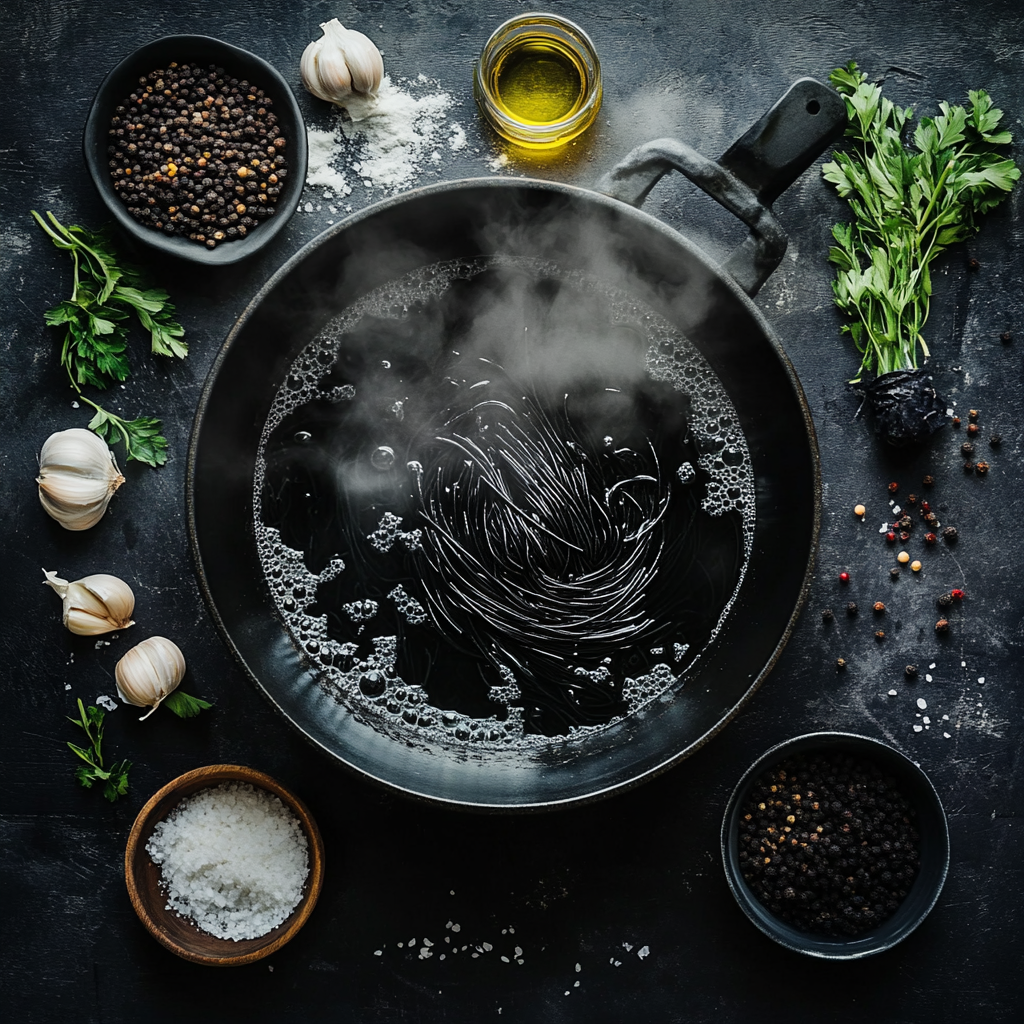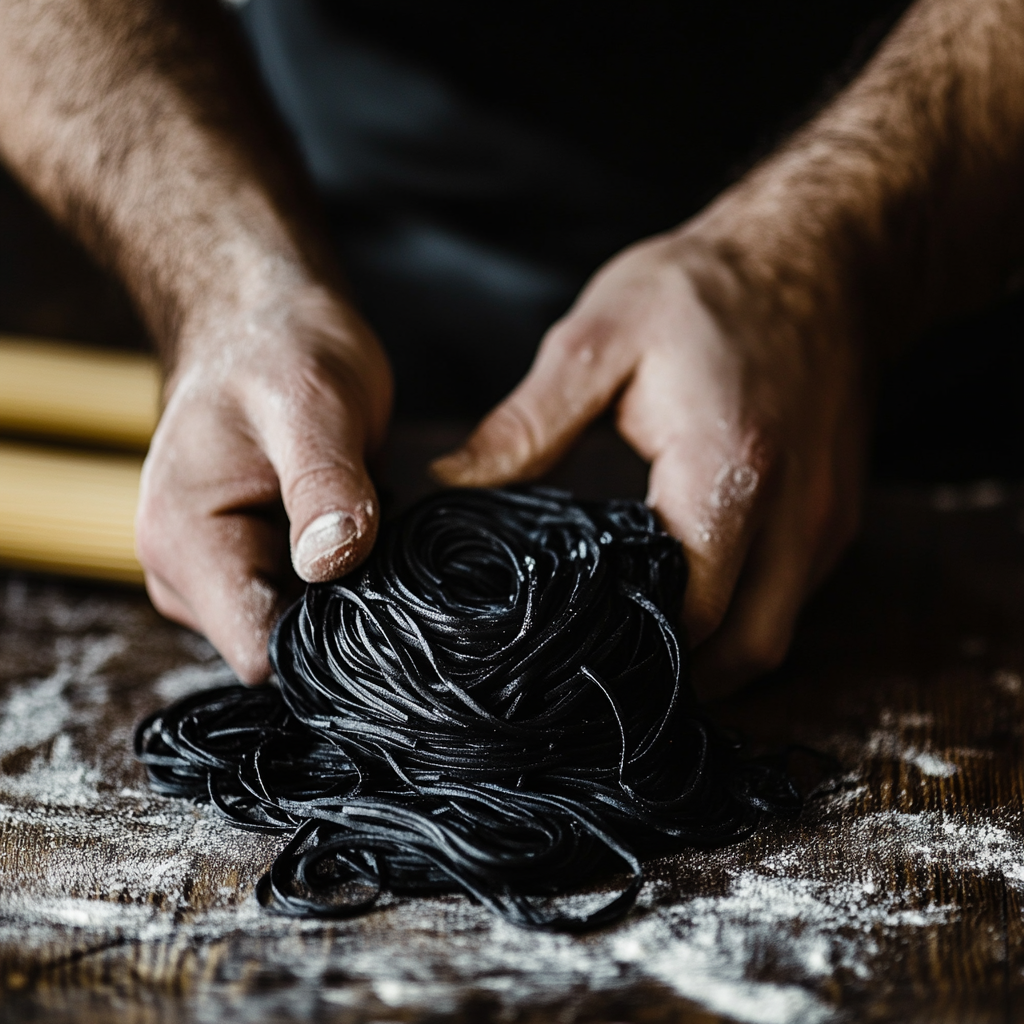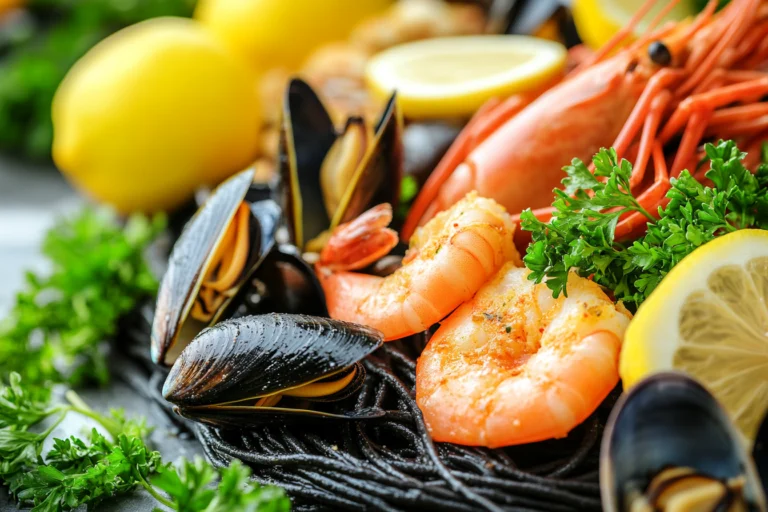Introduction
Black spaghetti, also known as squid ink pasta, is one of those culinary delights that catches the eye and tantalizes the taste buds. Its jet-black color, distinct flavor, and luxurious appeal make it a star of gourmet cuisine. But what exactly is this pasta made of? In this article, we’ll unravel its secrets, explore the main ingredient—squid ink—and guide you through how it’s made, cooked, and paired with complementary ingredients. Let’s dive in!
Table of contents
Introduction to Black Spaghetti
What Is Black Spaghetti?
Black spaghetti is a visually striking pasta made with squid ink as a key ingredient. Its rich black hue isn’t just for show—it carries a subtle, savory flavor that sets it apart from traditional pasta. Originating in coastal regions of Italy, where squid ink is a common ingredient, black spaghetti has since gained global acclaim.
This pasta isn’t just about looks, though. The unique taste, reminiscent of the sea, adds a touch of sophistication to any dish it graces. Whether paired with seafood or served in a minimalist style, black spaghetti is a testament to culinary creativity.
The Culinary Appeal of Black Spaghetti
The allure of black spaghetti lies in its exotic look and briny flavor. It’s not just food—it’s art on a plate. From upscale restaurants to ambitious home cooks, many are drawn to its bold color and the curiosity it inspires.
In gourmet cuisine, black spaghetti serves as the perfect canvas for vibrant sauces, fresh herbs, and seafood medleys. Its slightly chewy texture adds depth to every bite, making it an experience rather than just a meal.
Ingredients and Preparation
Main Ingredient: Squid Ink
The secret to black spaghetti’s bold look and unique flavor is squid ink. This natural ingredient, which comes from squid or cuttlefish, is what gives the pasta its signature dark color. However, it does more than just provide visual appeal. Squid ink adds a slightly briny taste that enhances the overall flavor of the dish.
Moreover, squid ink contains natural pigments like melanin, which create its dramatic black hue. Its savory, umami flavor works beautifully with seafood and other fresh ingredients, making it a favorite in coastal cuisines. These qualities explain why squid ink is often considered essential for creating authentic black spaghetti.
If you’re wondering where to find squid ink, don’t worry—it’s widely available. You can purchase it in jars or sachets from specialty food stores, Italian markets, or online retailers.
Basic Pasta Dough Components
At its core, black spaghetti begins with a simple pasta dough. Typically, the base includes just a few ingredients:
- Flour: Often all-purpose or semolina for a firmer texture.
- Eggs: Essential for binding the dough and adding richness.
- Olive oil: Used to make the dough smooth and elastic.
- Salt: Enhances the overall flavor.

A basic recipe might call for 2 cups of flour, 2 eggs, and a tablespoon of olive oil. However, some variations use water instead of eggs, while others mix flours to create a slightly different texture. Therefore, you can adjust the recipe depending on your preference or dietary needs.
Incorporating Squid Ink into Pasta Dough
Making black spaghetti at home is a straightforward process, but it does require attention to detail. Follow these steps to ensure success:
- Prepare the Ingredients: First, gather flour, eggs, olive oil, salt, and squid ink. Typically, you’ll need 1–2 teaspoons of squid ink for every cup of flour.
- Mix the Dough: Begin by making a well in the flour on a clean surface. Then, crack the eggs into the center, and add the olive oil, salt, and squid ink. Slowly mix the flour into the wet ingredients until the dough starts to come together.
- Knead Thoroughly: Once the dough is formed, knead it for 8–10 minutes. This step is important because it ensures the squid ink is evenly distributed, which creates a uniform color and texture.
- Rest the Dough: After kneading, wrap the dough in plastic wrap and let it rest for about 30 minutes. As a result, the gluten relaxes, making the dough easier to roll.
- Roll and Cut: Finally, roll the dough into thin sheets using a pasta roller or rolling pin, and cut it into your desired shape—spaghetti, fettuccine, or even tagliatelle.

If the dough feels sticky, sprinkle a small amount of flour. However, be careful not to add too much, as it could make the pasta tough. In addition, ensure the squid ink is fully mixed before kneading for the best results.
Homemade vs Store-Bought Black Spaghetti
When it comes to enjoying black spaghetti, you can choose to make it yourself or purchase a ready-made version. Both options have their advantages and disadvantages.
Homemade Black Spaghetti
- Advantages: Making it yourself allows you to control the ingredients and adjust the flavor and color. Plus, homemade pasta has a softer, fresher texture.
- Challenges: However, preparing pasta from scratch requires time, patience, and some specialized tools, like a pasta roller.
Store-Bought Black Spaghetti
- Advantages: On the other hand, store-bought black spaghetti is convenient and widely available. Many brands use real squid ink, ensuring authentic flavor.
- Challenges: That said, it may lack the freshness of homemade pasta. Additionally, some lower-quality brands might rely on artificial coloring instead of genuine squid ink.
Ultimately, whether you choose homemade or store-bought, black spaghetti is a versatile ingredient that can elevate any dish.
Cooking Black Spaghetti: Best Practices
Cooking black spaghetti may seem daunting, but it’s easier than you think if you follow a few essential steps. First, start with a large pot of water and add plenty of salt—about a tablespoon per gallon. This step is crucial because it enhances the pasta’s flavor. Once the water reaches a rolling boil, add the pasta.
If you’re using fresh black spaghetti, it cooks in just 2–4 minutes. However, dried spaghetti takes a bit longer, around 8–10 minutes. Be sure to check the packaging for exact times. To avoid overcooking, monitor the pasta closely and test for doneness by tasting.
After draining, toss the pasta immediately with your sauce. This not only keeps it from sticking but also allows it to soak up the flavors. Avoid rinsing the pasta unless the recipe specifically calls for it, as rinsing removes the starch that helps sauces cling to the noodles.
Common mistakes to avoid:
- Using too little water, which can cause the pasta to clump together.
- Overcooking, which makes the texture mushy and may dull the color.
- Forgetting to stir, as black spaghetti is more prone to sticking due to its delicate texture.
Flavor Pairings and Sauce Recommendations
When it comes to pairing sauces with black spaghetti, the options are plentiful. Traditional choices, as well as modern creations, bring out the best in this unique pasta.
Traditional Pairings
Black spaghetti naturally complements seafood-based sauces because its briny flavor mirrors the oceanic notes of squid ink. For example, squid, shrimp, and mussels pair beautifully with a light garlic and olive oil sauce. Additionally, tomato-based sauces provide a vibrant, acidic contrast that balances the pasta’s savory taste.
Modern Twists
On the other hand, modern interpretations often use creamy sauces with ingredients like mascarpone or parmesan for a rich and indulgent experience. Vegetarian options, such as roasted cherry tomatoes, sautéed spinach, or wild mushrooms, offer a fresh and earthy balance to the pasta’s briny profile.
Furthermore, spicy flavors can add a bold twist. For instance, a drizzle of chili oil or a pinch of crushed red pepper flakes can elevate the dish while maintaining its elegance. To finish, garnish with lemon zest, parsley, or grated cheese to enhance the presentation.
Seafood and Black Spaghetti: A Perfect Match
Seafood and black spaghetti are a classic combination for good reason. Not only does the pasta’s briny taste complement seafood, but its bold color also highlights the vibrant hues of shrimp, mussels, and clams.
Why seafood works so well:
- The natural saltiness of squid ink enhances the sweet and delicate flavors of seafood.
- The firm texture of the pasta contrasts perfectly with the tender bite of shrimp, squid, or scallops.
- Moreover, the visual appeal of colorful seafood against jet-black pasta creates a stunning presentation.
Popular Seafood-Based Dishes:
- Spaghetti al Nero di Seppia: This iconic Italian dish combines black spaghetti with tender squid in a garlic and tomato sauce.
- Shrimp and Lemon Pasta: A zesty pairing of juicy shrimp, fresh parsley, and a light butter sauce.
- Mussels in White Wine Sauce: Plump mussels tossed with black spaghetti in a flavorful garlic and white wine base.
Whether you prefer traditional recipes or modern spins, seafood brings out the best in black spaghetti, making it an unforgettable dining experience.
Cultural and Nutritional Insights
Cultural Significance in Italian Cuisine
Black spaghetti, or spaghetti al nero di seppia, has its roots in the coastal regions of Italy, particularly in Sicily and Venice. These areas, known for their abundant seafood, have embraced squid ink as an integral ingredient for centuries. The practice of using squid ink in pasta stems from a desire to minimize waste and make the most of available resources—a testament to the ingenuity of Italian cuisine.
Traditionally, black spaghetti dishes were crafted as humble, rustic meals that celebrated the flavors of the sea. Over time, they evolved into gourmet delicacies, now featured in high-end restaurants worldwide. One iconic preparation is Spaghetti al Nero di Seppia, a dish where black spaghetti is tossed with a rich sauce of squid, garlic, tomatoes, and white wine. This dish, rooted in tradition, remains a favorite in both Italy and beyond.
The appeal of black spaghetti extends beyond its flavor. Its striking appearance and association with Italian culinary heritage make it a sought-after dish, symbolizing both artistry and tradition in cuisine.
Nutritional Profile of Black Spaghetti
Black spaghetti isn’t just visually appealing—it also offers a nutritional twist. Like regular pasta, it serves as a source of carbohydrates, essential for energy.
Macronutrient Breakdown (per 100 grams):
- Calories: Approximately 300 (varies based on ingredients).
- Carbohydrates: 50–60 grams.
- Protein: 7–10 grams (higher if eggs are included in the dough).
- Fats: 1–3 grams.
The addition of squid ink enhances its nutritional profile. Squid ink contains antioxidants like melanin and proteins, which may support cellular health and boost immunity. Additionally, the minerals found in squid ink—such as iron and magnesium—add to the pasta’s health benefits.
However, moderation is key. Like all pasta, black spaghetti should be part of a balanced diet. Opt for fresh ingredients, such as seafood and vegetables, to create nutrient-rich dishes. For those watching their calorie intake, pairing black spaghetti with lighter sauces like olive oil and lemon can maintain its appeal without compromising health goals.
Nutritional Content (per 100g):
| Nutrient | Amount (per 100g) |
|---|---|
| Calories | 300 kcal |
| Carbohydrates | 50–60 g |
| Protein | 7–10 g |
| Fats | 1–3 g |
| Iron | 2 mg |
| Magnesium | 25 mg |
| Sodium | 50 mg |
Frequently Asked Questions
What is black spaghetti made of?
Black spaghetti, also called squid ink pasta, is made from the same basic ingredients as regular pasta: flour, eggs, olive oil, and salt. The key difference is the addition of squid ink, which gives the pasta its black color and adds a light salty flavor similar to the ocean. This makes it both tasty and visually unique.
Does black spaghetti taste different from regular pasta?
Yes, black spaghetti tastes different from regular pasta. While regular pasta has a mild flavor, black spaghetti has a slightly salty and savory taste due to the squid ink. This adds a little extra flavor, making it a great match for seafood or light sauces that highlight its unique taste.
Is squid ink safe to eat?
Yes, squid ink is safe to eat. It is commonly used in cooking around the world, especially in Mediterranean and Asian dishes. Squid ink is a natural ingredient that contains helpful nutrients and is not harmful. It is mainly used to add flavor and color to foods like pasta, risotto, and sauces.
Does black spaghetti taste different?
Yes, black spaghetti has a special taste. The squid ink gives it a mild salty flavor with a touch of the sea. This makes it pair very well with seafood sauces. While the taste difference is small, it adds a unique twist to the dish.
Is black ink spaghetti healthy?
Black ink spaghetti can be healthy, depending on how it is made. Squid ink has nutrients like antioxidants and iron, which may be good for you. However, the overall healthiness depends on the type of pasta (whole grain or refined) and the sauces or toppings used. Adding healthy options like seafood, vegetables, and olive oil can make the dish better for you.
Can I add food coloring to spaghetti?
Yes, you can add food coloring to spaghetti to make it colorful. You can mix it into the dough before cooking or soak cooked spaghetti in water with food coloring. It’s a fun way to make your dish look special, but artificial coloring doesn’t change the taste or add nutrition. For natural options, you can use spinach, beetroot, or turmeric to get different colors.
Conclusion
Embracing the Unique Qualities of Black Spaghetti
This pasta is more than just food—it’s a way to turn a simple dish into something exciting. Its dark color and unique flavor make it stand out in both looks and taste. Whether you’re making it at home or using pre-made options, it adds a special touch to your meals.
The good thing about this pasta is that it works well with many flavors. From seafood to fresh vegetables or creamy sauces, the options are endless. You don’t need to be a professional chef to enjoy it either. With a bit of effort, you can create a dish that feels fancy yet fun.
Why not give it a try? It’s an opportunity to explore something new and impress your family or guests. Once you taste it, you’ll understand why it’s loved by food enthusiasts everywhere.

